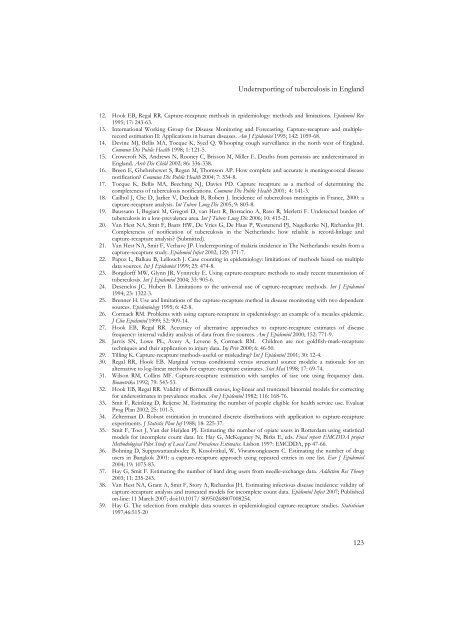Rob van Hest Capture-recapture Methods in Surveillance - RePub ...
Rob van Hest Capture-recapture Methods in Surveillance - RePub ...
Rob van Hest Capture-recapture Methods in Surveillance - RePub ...
You also want an ePaper? Increase the reach of your titles
YUMPU automatically turns print PDFs into web optimized ePapers that Google loves.
Underreport<strong>in</strong>g of tuberculosis <strong>in</strong> England<br />
12. Hook EB, Regal RR. <strong>Capture</strong>-<strong>recapture</strong> methods <strong>in</strong> epidemiology: methods and limitations. Epidemiol Rev<br />
1995; 17: 243-63.<br />
13. International Work<strong>in</strong>g Group for Disease Monitor<strong>in</strong>g and Forecast<strong>in</strong>g. <strong>Capture</strong>-<strong>recapture</strong> and multiplerecord<br />
estimation II: Applications <strong>in</strong> human diseases. Am J Epidemiol 1995; 142: 1059-68.<br />
14. Dev<strong>in</strong>e MJ, Bellis MA, Tocque K, Syed Q. Whoop<strong>in</strong>g cough surveillance <strong>in</strong> the north west of England.<br />
Commun Dis Public Health 1998; 1: 121-5.<br />
15. Crowcroft NS, Andrews N, Rooney C, Brisson M, Miller E. Deaths from pertussis are underestimated <strong>in</strong><br />
England. Arch Dis Child 2002; 86: 336-338.<br />
16. Breen E, Ghebrehewet S, Regan M, Thomson AP. How complete and accurate is men<strong>in</strong>gococcal disease<br />
notification? Commun Dis Public Health 2004; 7: 334-8.<br />
17. Tocque K, Bellis MA, Beech<strong>in</strong>g NJ, Davies PD. <strong>Capture</strong> <strong>recapture</strong> as a method of determ<strong>in</strong><strong>in</strong>g the<br />
completeness of tuberculosis notifications. Commun Dis Public Health 2001; 4: 141-3.<br />
18. Cailhol J, Che D, Jarlier V, Decludt B, <strong>Rob</strong>ert J. Incidence of tuberculous men<strong>in</strong>gitis <strong>in</strong> France, 2000: a<br />
capture-<strong>recapture</strong> analysis. Int Tuberc Lung Dis 2005; 9: 803-8.<br />
19. Baussano I, Bugiani M, Gregori D, <strong>van</strong> <strong>Hest</strong> R, Borrac<strong>in</strong>o A, Raso R, Merletti F. Undetected burden of<br />
tuberculosis <strong>in</strong> a low-prevalence area. Int J Tuberc Lung Dis 2006; 10: 415-21.<br />
20. Van <strong>Hest</strong> NA, Smit F, Baars HW, De Vries G, De Haas P, Westenend PJ, Nagelkerke NJ, Richardus JH.<br />
Completeness of notification of tuberculosis <strong>in</strong> the Netherlands: how reliable is record-l<strong>in</strong>kage and<br />
capture-<strong>recapture</strong> analysis? (Submitted).<br />
21. Van <strong>Hest</strong> NA, Smit F, Verhave JP. Underreport<strong>in</strong>g of malaria <strong>in</strong>cidence <strong>in</strong> The Netherlands: results from a<br />
capture-<strong>recapture</strong> study. Epidemiol Infect 2002; 129: 371-7.<br />
22. Papoz L, Balkau B, Lellouch J. Case count<strong>in</strong>g <strong>in</strong> epidemiology: limitations of methods based on multiple<br />
data sources. Int J Epidemiol 1999; 25: 474-8.<br />
23. Borgdorff MW, Glynn JR, Vynnycky E. Us<strong>in</strong>g capture-<strong>recapture</strong> methods to study recent transmission of<br />
tuberculosis. Int J Epidemiol 2004; 33: 905-6.<br />
24. Desenclos JC, Hubert B. Limitations to the universal use of capture-<strong>recapture</strong> methods. Int J Epidemiol<br />
1994; 23: 1322-3.<br />
25. Brenner H. Use and limitations of the capture-<strong>recapture</strong> method <strong>in</strong> disease monitor<strong>in</strong>g with two dependent<br />
sources. Epidemiology 1995; 6: 42-8.<br />
26. Cormack RM. Problems with us<strong>in</strong>g capture-<strong>recapture</strong> <strong>in</strong> epidemiology: an example of a measles epidemic.<br />
J Cl<strong>in</strong> Epidemiol 1999; 52: 909-14.<br />
27. Hook EB, Regal RR. Accuracy of alternative approaches to capture-<strong>recapture</strong> estimates of disease<br />
frequency: <strong>in</strong>ternal validity analysis of data from five sources. Am J Epidemiol 2000; 152: 771-9.<br />
28. Jarvis SN, Lowe PL, Avery A, Levene S, Cormack RM. Children are not goldfish-mark-<strong>recapture</strong><br />
techniques and their application to <strong>in</strong>jury data. Inj Prev 2000; 6: 46-50.<br />
29. Till<strong>in</strong>g K. <strong>Capture</strong>-<strong>recapture</strong> methods-useful or mislead<strong>in</strong>g? Int J Epidemiol 2001; 30: 12-4.<br />
30. Regal RR, Hook EB. Marg<strong>in</strong>al versus conditional versus structural source models: a rationale for an<br />
alternative to log-l<strong>in</strong>ear methods for capture-<strong>recapture</strong> estimates. Stat Med 1998; 17: 69-74.<br />
31. Wilson RM, Coll<strong>in</strong>s MF. <strong>Capture</strong>-<strong>recapture</strong> estimation with samples of size one us<strong>in</strong>g frequency data.<br />
Biometrika 1992; 79: 543-53.<br />
32. Hook EB, Regal RR. Validity of Bernouilli census, log-l<strong>in</strong>ear and truncated b<strong>in</strong>omial models for correct<strong>in</strong>g<br />
for underestimates <strong>in</strong> prevalence studies. Am J Epidemiol 1982; 116: 168-76.<br />
33. Smit F, Re<strong>in</strong>k<strong>in</strong>g D, Reijerse M. Estimat<strong>in</strong>g the number of people eligible for health service use. Evaluat<br />
Prog Plan 2002; 25: 101-5.<br />
34. Zelterman D. <strong>Rob</strong>ust estimation <strong>in</strong> truncated discrete distributions with application to capture-<strong>recapture</strong><br />
experiments. J Statistic Plan Inf 1988; 18: 225-37.<br />
35. Smit F, Toet J, Van der Heijden PJ. Estimat<strong>in</strong>g the number of opiate users <strong>in</strong> Rotterdam us<strong>in</strong>g statistical<br />
models for <strong>in</strong>complete count data. In: Hay G, McKeganey N, Birks E, eds. F<strong>in</strong>al report EMCDDA project<br />
Methodological Pilot Study of Local Level Prevalence Estimates. Lisbon 1997: EMCDDA, pp 47-66.<br />
36. Bohn<strong>in</strong>g D, Suppawattanabodee B, Kusolvitkul, W, Viwatwongkasem C. Estimat<strong>in</strong>g the number of drug<br />
users <strong>in</strong> Bangkok 2001: a capture-<strong>recapture</strong> approach us<strong>in</strong>g repeated entries <strong>in</strong> one list. Eur J Epidemiol<br />
2004; 19: 1075-83.<br />
37. Hay G, Smit F. Estimat<strong>in</strong>g the number of hard drug users from needle-exchange data. Addiction Res Theory<br />
2003; 11: 235-243.<br />
38. Van <strong>Hest</strong> NA, Grant A, Smit F, Story A, Richardus JH. Estimat<strong>in</strong>g <strong>in</strong>fectious disease <strong>in</strong>cidence: validity of<br />
capture-<strong>recapture</strong> analysis and truncated models for <strong>in</strong>complete count data. Epidemiol Infect 2007; Published<br />
on-l<strong>in</strong>e: 11 March 2007; doi:10.1017/ S0950268807008254.<br />
39. Hay G. The selection from multiple data sources <strong>in</strong> epidemiological capture-<strong>recapture</strong> studies. Statistician<br />
1997;46:515-20<br />
123

















